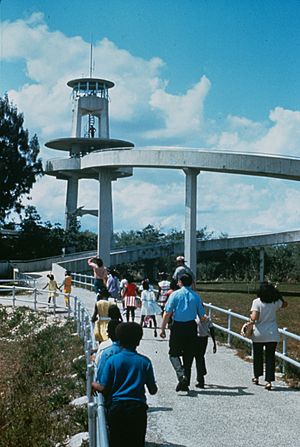Shark Valley facts for kids
Quick facts for kids Shark Valley |
|
|---|---|

Shark Valley trail and observation tower
|
|
| Location | Everglades National Park (ENP) |
| Nearest city | Miami |
| Created | 1947 (ENP) |
| Operated by | National Park Service |
| Status | Open all year |
Shark Valley is a special low-lying area in Florida, USA. It's part of Everglades National Park. Water from Shark Valley flows into the Shark River, which then reaches the Ten Thousand Islands. This area is mostly a 'sawgrass prairie,' which means it's covered in a type of grass called sawgrass. During the rainy season, this prairie floods, creating what people call a "river of grass." The local Mikasuki people call these marshes Pa-Hay-Okee.
Shark Valley has a Visitor Center where you can learn a lot. It has displays, a video about the park, and even an underwater camera! You can find the entrance to Shark Valley along the Tamiami Trail (also known as US 41).
Contents
What Makes Shark Valley Special?
Shark Valley has large areas of limestone rock. This rock is either visible or covered by a type of mud called marl. The area gets wet during the rainy season, but it doesn't stay flooded all year like some other parts of the Everglades. The main plant you'll see here is sawgrass.
Amazing Animals of Shark Valley
Shark Valley is home to many cool animals. You might spot alligators, ibis birds, wood storks, and beautiful roseate spoonbills. Other animals include raccoons, white-tailed deer, and different kinds of frogs and salamanders. It's a great place to see Florida's wildlife!
A Look Back: History of Shark Valley
Shark Valley has an interesting history, including events from the Second Seminole War. In the late 1830s, some groups of Native Americans, sometimes called "Spanish Indians," were active in the area. These groups were a mix of Creek people and others with Native American and Spanish backgrounds.
The Story of Chakaika's Island
In December 1840, a group of 90 soldiers, led by Lieutenant Colonel W. S. Harney, went looking for a leader named Chakaika. They traveled from Fort Dallas (which is now Downtown Miami) into the Everglades. They found Chakaika and some of his group. Chakaika was captured and sadly died on what became known as "Chakaika's island." Many people believe this island is the same as present-day Chekika Island, right at the start of Shark Valley.
The tall observation tower you can see at Shark Valley was designed by a famous architect from South Florida named Edward M. Ghezzi.
Images for kids
-
American Alligator at Shark Valley in Everglades National Park
-
Two American Alligators next to the bike path at Shark Valley




